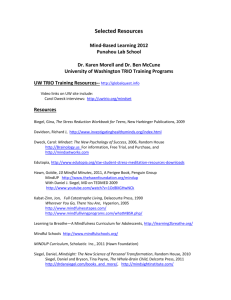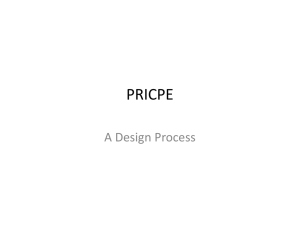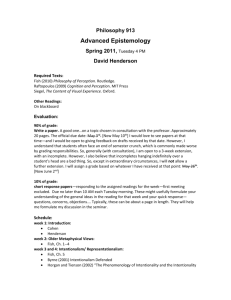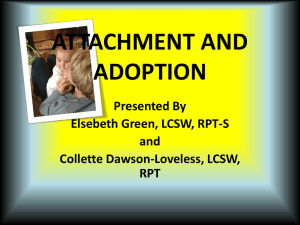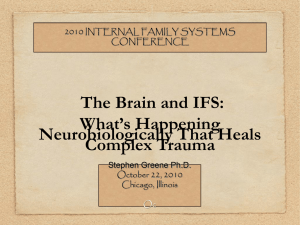Brainstorm summary
advertisement
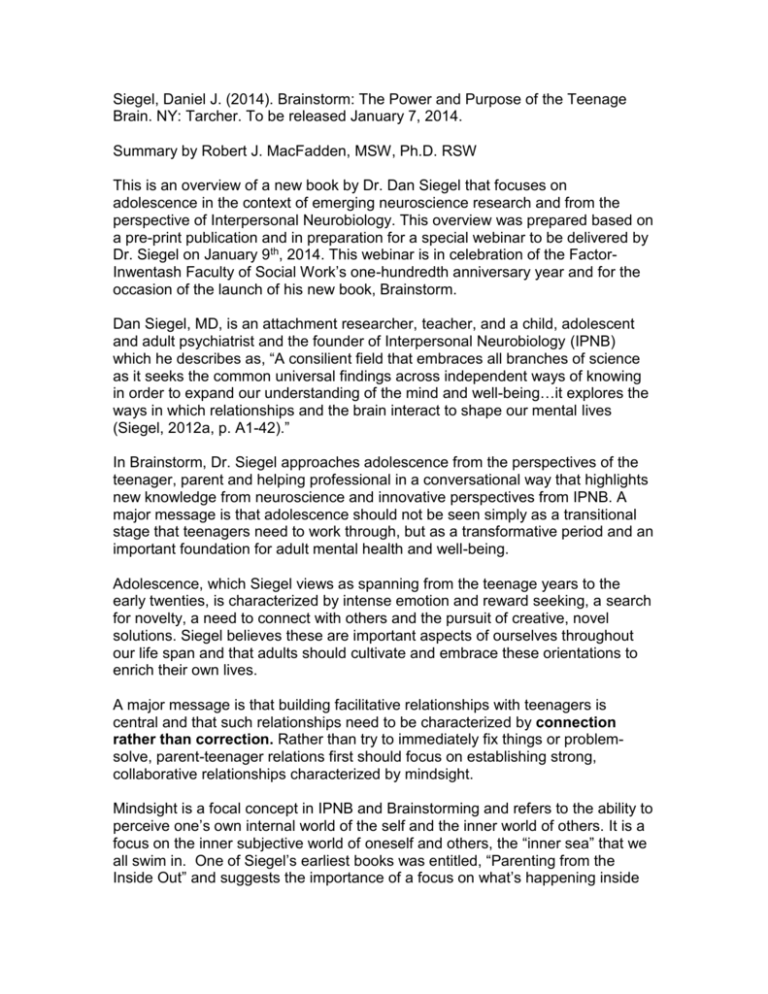
Siegel, Daniel J. (2014). Brainstorm: The Power and Purpose of the Teenage Brain. NY: Tarcher. To be released January 7, 2014. Summary by Robert J. MacFadden, MSW, Ph.D. RSW This is an overview of a new book by Dr. Dan Siegel that focuses on adolescence in the context of emerging neuroscience research and from the perspective of Interpersonal Neurobiology. This overview was prepared based on a pre-print publication and in preparation for a special webinar to be delivered by Dr. Siegel on January 9th, 2014. This webinar is in celebration of the FactorInwentash Faculty of Social Work’s one-hundredth anniversary year and for the occasion of the launch of his new book, Brainstorm. Dan Siegel, MD, is an attachment researcher, teacher, and a child, adolescent and adult psychiatrist and the founder of Interpersonal Neurobiology (IPNB) which he describes as, “A consilient field that embraces all branches of science as it seeks the common universal findings across independent ways of knowing in order to expand our understanding of the mind and well-being…it explores the ways in which relationships and the brain interact to shape our mental lives (Siegel, 2012a, p. A1-42).” In Brainstorm, Dr. Siegel approaches adolescence from the perspectives of the teenager, parent and helping professional in a conversational way that highlights new knowledge from neuroscience and innovative perspectives from IPNB. A major message is that adolescence should not be seen simply as a transitional stage that teenagers need to work through, but as a transformative period and an important foundation for adult mental health and well-being. Adolescence, which Siegel views as spanning from the teenage years to the early twenties, is characterized by intense emotion and reward seeking, a search for novelty, a need to connect with others and the pursuit of creative, novel solutions. Siegel believes these are important aspects of ourselves throughout our life span and that adults should cultivate and embrace these orientations to enrich their own lives. A major message is that building facilitative relationships with teenagers is central and that such relationships need to be characterized by connection rather than correction. Rather than try to immediately fix things or problemsolve, parent-teenager relations first should focus on establishing strong, collaborative relationships characterized by mindsight. Mindsight is a focal concept in IPNB and Brainstorming and refers to the ability to perceive one’s own internal world of the self and the inner world of others. It is a focus on the inner subjective world of oneself and others, the “inner sea” that we all swim in. One of Siegel’s earliest books was entitled, “Parenting from the Inside Out” and suggests the importance of a focus on what’s happening inside the minds of a child and parent. Not seeing the mind (self and other) can promote disrespect and a lack of compassion. We create mindsight maps of me (insight), you (empathy) and we (morality). Fostering mindsight builds self-awareness and emotional control, enhanced empathy and rich relationships. It leads to integration by honouring differences and promoting compassionate connections and through integration creates health in our bodies, relationships and minds. Mindsight leads to neural integration which creates co-ordination and balance within the nervous system which is also called “self-regulation”. So mindsight promotes self-understanding and empathy, self-regulation within oneself, within others and across relationships. How we focus our attention will change the brain in important ways. It changes the brain’s firing and circuitry. Intentional attention focuses and strengthens specific functions. Siegel uses the analogy of a wheel (“Wheel of Awareness”), with a hub and spokes to describe how to foster mindfulness. The rim contains segments such as (1) our five senses-sight, hearing, smell, taste and touch; (2) the sixth sense or inner sensations of muscles, bones, internal organs; (3) mental processes such as feelings thoughts, beliefs, intentions, memories and (4) a relational sense involving perceptions we have of other people, our environment and planet. The hub reflects our sense of knowing within awareness. The elements of the rim are connected to the hub through the process of attention. Starting from the hub and focusing attention on the various segments on the rim and experiencing these various senses, thoughts, feelings, sensations around the rim enables some people to use the focus of the hub to help them experience stimuli that have been problematic. For instance, Siegel quotes one teenager as saying, “nervousness and worries just became points on the rim that I could sense from that calmer place on the hub”. Siegel offers a “Mindsight Simple Seven” particularly relevant for adolescence. The first is ensuring “Time-In” which is consistent mindfulness practice in reflection and exploring mental lives such as feelings, memories, beliefs and bodily sensations. This activity builds fibers in the brain to help regulate attention, emotion and thinking and improve empathy and compassion. The second is ensuring adequate time for sleep (e.g., United States National Sleep Foundation recommends 8.5 to 9.25 hours per night for adolescents) which promotes memory consolidation, optimal insulin functioning and food metabolism, improved immune function, enhanced response to stress, increased mental function such as thinking, remembering, problem-solving and focused attention. 2 The third is time to focus. This involves focusing on one thing at a time, rather than constantly shifting focus while working on several things. Time focused on one activity enhances neuroplasticity and allows synaptic change to occur. The fourth is ensuring adequate downtime to unwind and relax. The fifth is building in play time which entails spontaneous activity, non-competitive, fun with a level of unpredictability. This forms the basis for creativity and innovation and play with others, enhances connection and pleasure. The sixth is physical activity which builds the brain and enhances neuroplasticity and mood. The seventh is ensuring time for connection with others. Siegel says we are built to collaborate and face-to-face time in particular is a rich source of satisfaction which changes the brain in important ways. Connected with mindsight and mindfulness awareness is presence which is the ability to be open and receptive to others and ourselves, ready to receive and to connect. Indeed, Siegel says that as a parent being “present” creates the best conditions for child and adolescent growth and development. It involves the ability to suspend expectations and judgments and to be able to hear oneself and others in an authentic way. This is particularly important in working with and living with teenagers. Siegel emphasizes how essential it is to stay open and accepting to the changes and challenges of adolescence. Presence allows us to be aware of what is happening in the moment, being receptive to our own inner sea and attuning to the inner life of the other. We resonate and feel their feelings. Feeling felt is the basis of secure attachment and the essence of healthy relationships. It is the first most important thing in a relationship that fosters deep connection. We don’t have to agree on everything, but if we start with connection it can be helpful in exploring issues together. Presence reflects the importance of being open to what the adolescent is experiencing and to honour the person an adolescent is becoming. Siegel uses the acronym of PART to describe the essential PART we play in cultivating healthy relationships. It stands for being Present, Attune, Resonate and create Trust. Siegel cites research supporting the importance of presence in improving physiological health, enhanced immune system functions and increased cell life. It also reduces stress, reduces the impact of aging on our telomeres (caps on the ends of our DNA) and increases happiness. Some other points Siegel offers: Repairing ruptures are important in parent and adolescent relationships. All significant relationships experience ruptures. This is particularly so with parents and adolescents where so many challenges can promote misunderstandings. As 3 a parent, one approach to healing a rupture is to make a statement about your interest in connecting again and to explore the adolescent’s experience first within a reflective dialogue. We need to reflect on these ruptures and reconnect quickly. A central theme of parent-adolescent relationships should be to keep open lines of communication ongoing. Adolescents are more susceptible to addiction, especially if started early. There are more dopamine spikes and valleys with more of “trough” in a resting state, suggesting a tendency to become bored and needing stimulation. There is a strong need for peer connection and for seeking rewards and novelty in adolescence. This can lead to risky behaviours especially when peers are present. Adolescents may not be just more impulsive, but may be more hyper-rational, evaluating pros and cons but de-emphasizing the significance of the cons. Brainstorm highlights attachment as fundamental to understanding and working with adolescents. As parents we need to be aware of our own issues and predilections and the impact of these on our relationships. Siegel notes that while our experiences in the first dozen years of life have a powerful impact on who we are, relationships continue to play a major role in growth and development in adolescence. He asserts that understanding what happened to you in early life and how you responded to those experiences in the past can lead to a more healthy and productive life. Indeed, relationships with caregivers and others while we are very young most directly shape who we have become. Siegel asserts that research and experience tells us that with self-reflection and understanding, problematic ways of parenting can be transformed. Attachment relationships with parents and other caregivers form internal models of attachment which are brain circuits that reflect schema that help us to predict what will happen next, how we should behave, what emotions we will have, and how others will respond to us. These models or brain states influence how we behave and react under different conditions. Both parents and adolescents can benefit from understanding what kind of attachment models we have developed in our early childhood that explain what is happening now and how new ways of living can be developed to overcome limitations from these early models. Siegel describes the four types of attachment models within a brain context. A secure attachment model allows us to support the essence of adolescence through fostering safety and security. This promotes emotion and passion, social engagement, seeking novelty and exploring creativity. 4 Attachment involves being seen, being safe, being soothed and feeling secure. Parents who provide this in at least a somewhat consistent way foster secure attachment in their children. Moving from infancy to being a toddler, this sense of safety is reflected in a state of mind that is secure: we feel good about ourselves, about others and believe our needs will be met. We believe we will be able to connect with others who will see our minds, help us to feel felt and meet our needs. Siegel views this as the solid sense of self that evolves for those with secure attachment models. Having a secure attachment model enables adolescents to cope with the transformations and challenges which are part of this period of life. Research has identified a link between secure attachment and important integrative prefrontal functions which include regulating the body, attunement to others and oneself, flexibility, being able to sooth our fears, increased insight, empathy for others and enhancing morality and resiliency. Insecure models of attachment include avoidant, ambivalent and disorganized types. This essentially means that people don’t consistently experience been seen, safe and soothed, nor do they feel secure in primary attachment relationships. There is less neural integration. These models persist throughout life but they are changeable if they are understood. Avoidant attachment with a caregiver evolves when you are not soothed when distressed, nor connected with when you feel unseen. There is no benefit from the caregiver which leads to minimizing attachment needs and feeling disconnected from others and your own emotions and needs. Individuals with this orientation have a “dismissing” state of mind. Siegel believes that individuals with an avoidant attachment have an undeveloped right hemisphere where our autobiographical memory and emotional needs and feelings are stored. Additionally personal reflection draws on autobiographical memory and our gut feelings and sensations arise and end up on the right side of the brain. In individuals with avoidant attachment, these important ways of knowing are not experienced much. Avoidant attachment seems to rely on the left brain as a way of adapting to a disconnected emotional life. An ambivalent model of attachment develops when a child experiences inconsistency or intrusiveness from a caregiver. Experiencing being seen and soothed does not occur in a consistent way- there is no reliable safe harbour. Attachment needs are amplified because of the experience of intrusiveness and inconsistency. Siegel indicates that ambivalence may suggest an overreliance on the right side of the brain. There is an intrusion of images and emotions without the balancing 5 of the left brain’s role in keeping track of the language output. It is as if the right brain is overwhelming the left brain’s answering of questions. A disorganized model of attachment involves being terrified of a caregiver. Our normal survival reaction to terror is to flee and to seek safety with a caregiver. When the caregiver is the source of terror there is no safe harbour and our self can become fragmented which can lead to dissociation. Disorganization makes it difficult to balance emotions, develop good relationships and think clearly under stress. This model of attachment may reflect an impaired co-ordination of both hemispheres. As the left brain tries to narrate a story, it can become disoriented and loses track of time and topic. The right brain may send elements of a lived past to the left brain which cannot be decoded by the left. In trauma, past body memories and images can flood consciousness as if they are happening in the present. Left and right brain integration can become blocked, along with dis-integration of layers of memory and prefrontal coordination. Unresolved trauma or loss can be viewed as a form of disorganization reflected in a “disorganized model of attachment”. Summary Brainstorming reminds us of the remarkable findings based on neuroplasticity that tells us that deliberately directing one’s attention in certain ways helps to build and strengthen brain circuits, brain functions and enhances well-being. Paying intentional attention within the context of following the breath in a way that fosters curiosity, openness, acceptance and love to feelings, thoughts, beliefs that arise while meditating, strengthens brain circuits. This can improve regulatory functions, enhance empathy, strengthen emotional control, decrease reactivity and strengthen the foundation of morality. So the mindfulness that Siegel advocates for both parents and adolescents, is more than just promoting reflection and insight which are important. It actually physically builds and strengthens circuitry in a way that promotes individual and relational well-being. Secure attachment, a core concept in Brainstorming, is achieved through open, and responsive relationships characterized by mindsight. Parents are able to create a secure and safe relationship where children are able to be seen and soothed. This changes the child’s brain circuitry in a way that builds self-control, positive self-esteem and a belief that others will be supportive. 6 How does secure attachment connect with mindfulness? It appears that many of the benefits fostered by caregivers that lead to secure attachment are similar to those created by practicing mindfulness meditation. Siegel believes that mindfulness meditation involves the meditator creating a secure attachment with oneself. Meditation practice leads to similar brain changes as experienced by someone who has been in a rich relationship that leads to a secure attachment. Siegel reports that the results of secure attachment and the effects of ongoing meditation show a remarkable similarity. Siegel concludes Brainstorm with noting that adolescence is a time of great integration including the integration of identity. He highlights the importance of humanity moving from “me to we” and invents the term “MWe” to highlight how we need a differentiated personal self that also needs to be connected with others. Our minds, “…emerge as much from our bodies and brains as from our relationships with one another and with our planet.” (Siegel, 2014, ccxxxi). For Siegel, the essence of adolescence such as the emotional spark, the intense social engagement and drive towards creative exploration can help to power the drive towards integration or “MWe” and result in well-being for the self, our relationships and our planet. Other books from Dan Siegel: Siegel, Daniel J. (2012a ). The pocket guide to Interpersonal Neurobiology. NY: W.W. Norton & Company. Siegel, Daniel J. (2012b). The developing mind: How relationships and the brain interact to shape who we are. Second Edition. NY: Guilford Press. Siegel, Daniel J., & Bryson, T. P. (2011). The whole brain child. NY: Delacorte Press. Siegel, Daniel J. (2010a). The mindful therapist: A clinician’s guide to mindsight and neural integration. NY: W. W. Norton & Company. Siegel, Daniel J. (2010b). Mindsight: The new science of personal transformation. New York: Bantam Books. Siegel, Daniel (2007). The mindful brain: Reflection and attunement in the cultivation of well-being. NY: W.W. Norton & Company. Siegel, Daniel J., & Hartzwell, Mary (2003). Parenting from the inside out: How a deeper self-understanding can help you raise children who thrive. NY: 7 Penguin. 8
